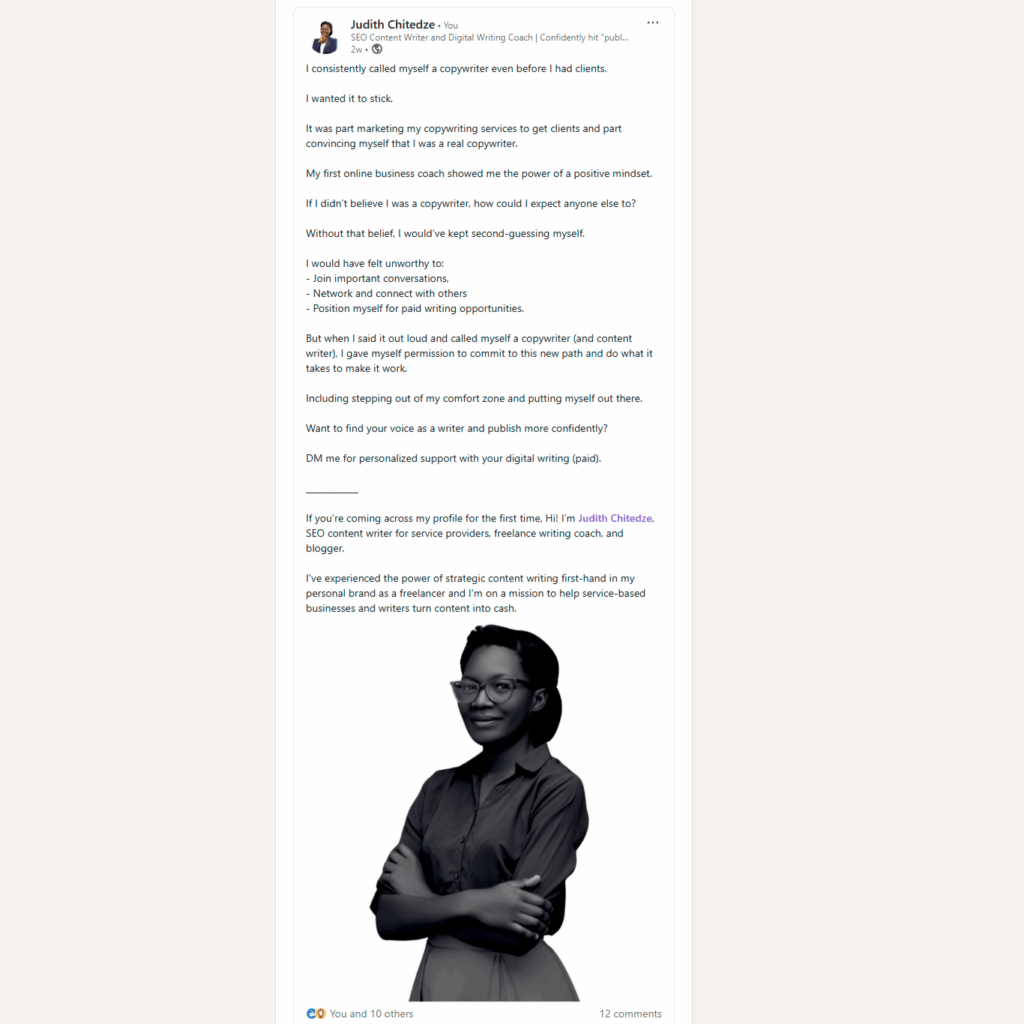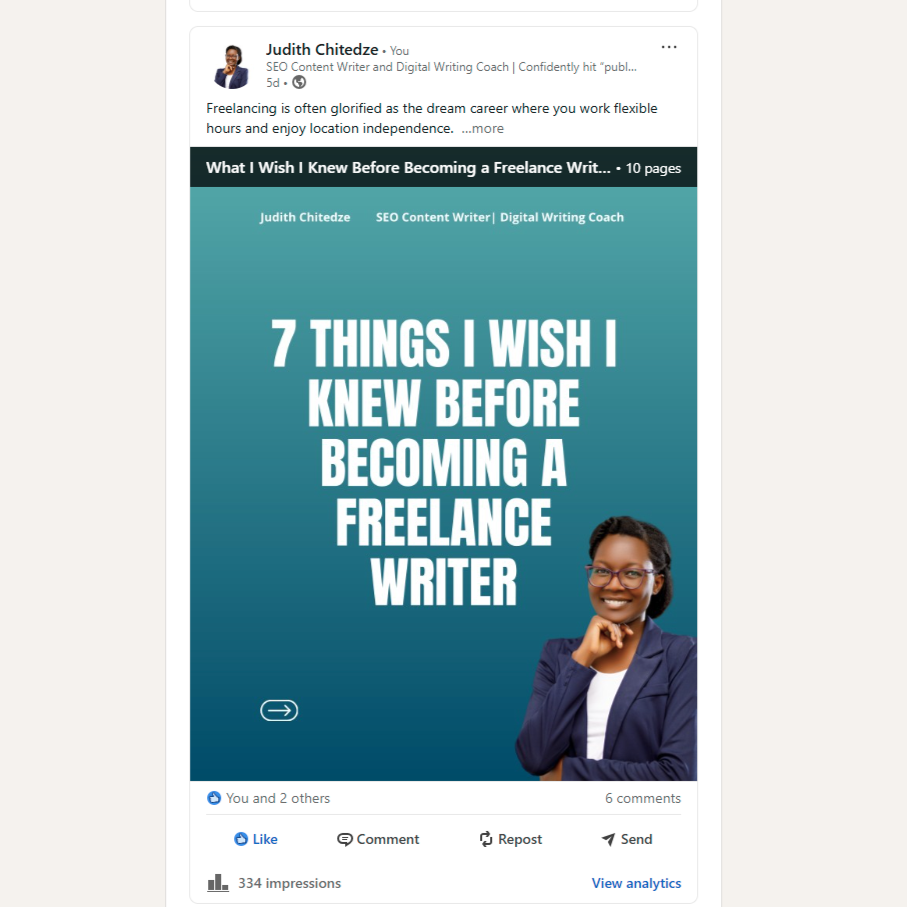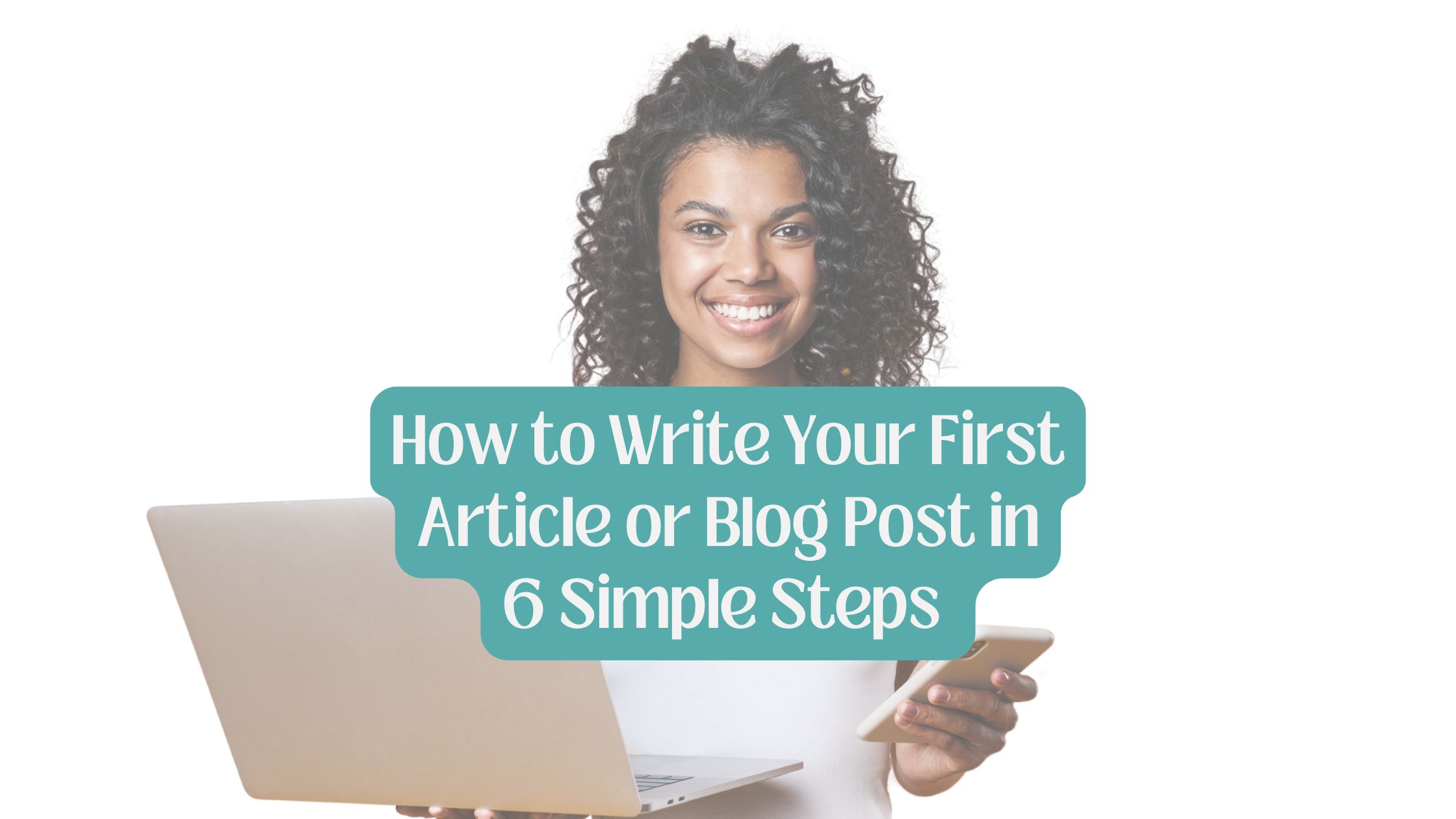LinkedIn is a great place to be if you’re a writer or service provider.
But many people feel intimidated by the “professional” vibe and think they have nothing interesting to share.
I’m about to show you that you’re more interesting than you think.
And you do have a story worth telling.
Just last year, I was also struggling to write on LinkedIn.
I wasn’t sure what to post to attract clients or build an audience.
Now it’s become second nature it feels weird to go days without engaging on the platform.
Writing on LinkedIn helps you build a strong personal brand as a writer, service provider, or business owner.
And strong personal brands attract career and business opportunities.
If you have no backup plan to fall on if you lost your job, start writing on LinkedIn.
You’ll start building something sustainable that no one can fire you from.
If I were starting over, these are the tips I would use to start writing on LinkedIn and get noticed.
1. Leverage Your Personal Story to Start Writing on LinkedIn
The hardest part for beginners is finding LinkedIn content ideas.
Start with your personal story.

“We need stories in order to know ourselves”
Storytelling helps you connect with others and yourself.
But don’t just share random stories.
Think about what you want to achieve by writing on LinkedIn.
I’m sure there’s a monetary reason somewhere in there.
So tell your story in a way that ties back to your offer.
When I started writing on LinkedIn, I had a general idea that I wanted to become a freelance copywriter.
I didn’t have a detailed plan, but I knew copywriting would require me to write a lot.
So I set off to learn how to write like a copywriter and practiced in public by posting on LinkedIn five times a week.
I wrote about copywriting (what I was learning), communication, and being intentional as an introvert.
Eventually, I built an audience and I’m getting a lot more engagement than ever before.
Always include a key takeaway for your audience when sharing your story.
It’s not a journal entry. It’s meant to serve your reader.
Think about what career or business lesson someone can learn from your story, whether you’re sharing about decluttering your living space or learning something new in your field.
Is it patience? The important of working with a strategy to avoid overwhelm or disorganization? Responsibility and being environmentally conscious when disposing of your clutter?
Each piece of content should tie back to your big-picture goals and audience.
2. Develop a LinkedIn Content Strategy
A content strategy keeps you from posting randomly and going around in cicles.
As humans, we’re multifaceted and have endless stories to tell.
But not all stories are relevant.
I usually advise my 1:1 freelance coaching clients to come up with three main topics to talk about for a start.
These are called content pillars or content categories.
For example, if you’re a web developer, your content pillars can be:
- Your personal story: How you got into web design, why, lessons learnt, projects you’ve worked on, projects you’d love to work on, your interests, etc to help you form real connections with your ideal audience.
- Educational content: Tips about your web design process, design decisions, or tips for beginner developers. Educational content helps you get the attention of potential clients as they see that you really know your craft.
- Client success stories: Demonstrate the results your clients should expect to get when they work with you. Share real-life stories of how you helped clients (paying or non paying) achieve desired results. If you haven’t worked with any clients yet, paint a picture of what a client will gain by working with you.
Once you choose your content pillars, plan your posts accordingly.
If you’re posting three times a week, you could share a personal story on Mondays, an educational tip on Wednesdays, and a success story or testimonial on Fridays.
Alternate between these categories on the different days you post.
This helps you balance connection and conversion.
Your personal stories build trust.
Your educational posts show expertise.
Your social proof posts sell your services.
3. Write an Introduction Post
If you’ve been inactive on LinkedIn for a while, it’s always nice to start off by introducing yourself.
Tell us who you are, what you do, and the results you help people get.
Talk about your skills and how they help you perform your work.
Mention your goals and what kind of opportunities you’re looking for.
This helps like-minded people find and connect with you.
If you’re a blogger and you say this in your post, I’ll be interested in following your journey because that’s right up my alley.
I’d love to get to know you.
But if you say nothing, people will have a hard time connecting with you.
So write a strong LinkedIn post to introduce yourself and invite us into your world.
4. Structure Your LinkedIn posts to Drive Engagement
Your post needs three key parts:
i) The Hook
The first two lines of your LinkedIn post should grab attention.
Start with an interesting statistic, a bold question, an unexpected insight, or a relatable moment to get readers to stop scrolling and click “read more.”

Know what your target audience wants to hear and use it to inform your choice of words.
This usually takes time so be patient with yourself.
ii) The Body
Deliver on the hook.
Focus on helping your audience solve a problem or gain clarity about the topic at hand.
Make it actionable when you can.
Do your market research to learn more about your target audience. Find out what solutions they’re looking for around your area of expertise be it web design, copywriting, personal branding, or whatever it is that you want to do.
I like reading posts that give me practical answers I can implement right away. So I also try to make my posts actionable as much as possible to help my audience leave better than they came.
iii) The Call to action (CTA)
Tell people what to do next by asking a simple question, inviting them to connect with you, or check out your offer.
You can also use proven copywriting frameworks like PAS (Problem, Agitate, Solution) to structure your posts for maximum engagement.
5. Make Your LinkedIn Posts Visually Appealing

Visuals are a big part of writing on LinkedIn.
- Post your photo to go with your text
- Create carousels in Canva
- Share infographics
- Create videos
Changing up your content format keeps things interesting for your audience and keeps them coming back for more.
Avoid using stock images and videos. They don’t perform well.
I made this mistake as a beginner and wondered why I had low engagement and reach.
Don’t make the same mistake.
Real, relatable visuals make your posts stand out and feel more human.
6. Be Authentic
Keep it real and let your personality show in your LinkedIn content.
Don’t just share wins, share the messy side of things too.
Social media is known as the place for sharing highlights.
Most people only share wins and “perfect” moments.
But I’ve noticed a shift lately, and more and more people are embracing building in public and sharing their full journey, including the struggles.
And those people are growing their accounts quickly because who doesn’t want such transparency?
Their audience is cheering them on when they hit a roadblock and they’re celebrating with them when they win.
So make people feel something with your content.
It’ll help you build a loyal following that’ll be ready to buy from you as soon as you have an offer.
That’s how you become a customer favorite.
And that’s how brands are winning online.
Avoid exaggerating or pretending to be something you’re not.
Honesty matters in business and in life.
Just be wise and avoid oversharing especially about your challenges.
Treat this as that famous interview question: “What are your weaknesses?”
You don’t want to shoot yourself in the foot!
7. Study Well-Performing Posts
Actively seek out other creators in your areas of interest and study their LinkedIn content.
What topics are they covering?
What kind of engagement are they getting?
How do they structure their posts?
How often do they post?
Use this research to guide your own content strategy.
Studying well-performing LinkedIn posts is also a great way to figure out how to monetize your skills or expertise.
If people are listening and responding well when they talk about blogging, you have proof of concept that there’s a ready market for that topic.
Pay attention to:
- How they start their posts
- Their formatting (short sentences and lots of white space),
- How they end the posts
- Posting times
Then create your own routine and start posting.
Keep writing and stay curious about how LinkedIn works.
You don’t need to master the algorithm.
Just start writing on LinkedIn consistently and focus on being helpful.
That’s how you grow.
How’s your LinkedIn personal branding journey going so far? I’d love to hear your story in the comments!




5 Responses
Awesome https://is.gd/N1ikS2
Good https://is.gd/N1ikS2
Very good https://is.gd/N1ikS2
Very good https://is.gd/N1ikS2
Good https://is.gd/N1ikS2